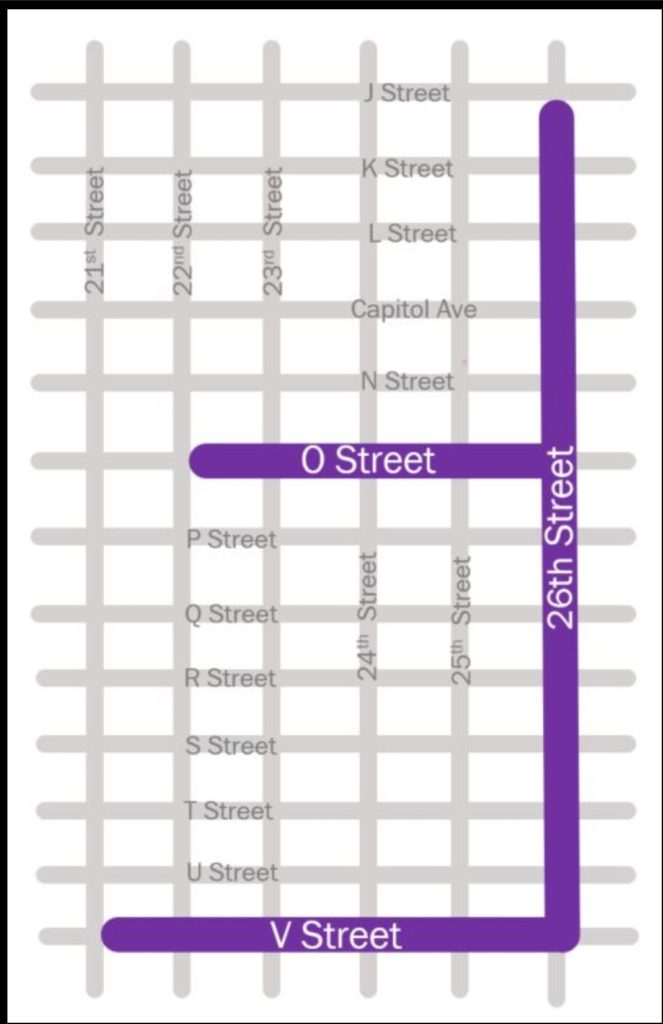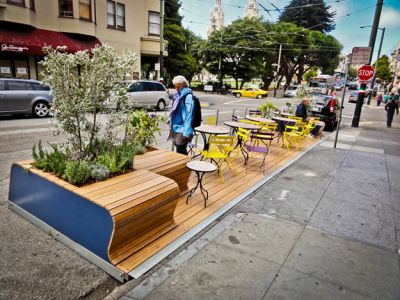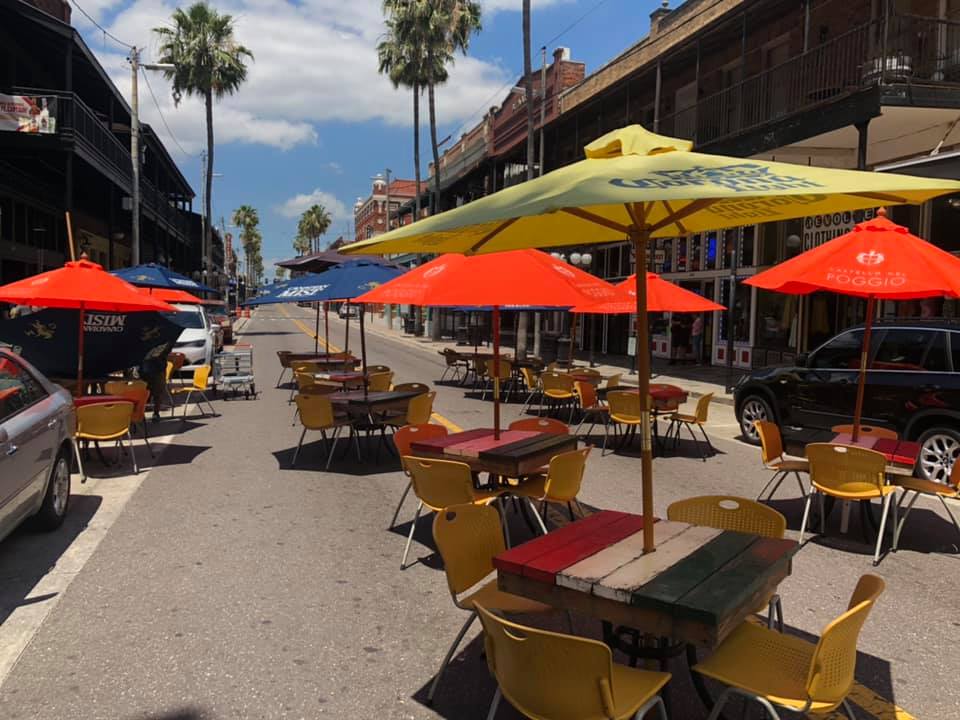Stay connected with News, Action items and Happenings

Update: October 15, 2021
The Slow and Active Streets Pilot has come to a close in Sacramento and the City's Public Works Dept. has put out a report about the effort. Read the entire report here.
Here are our takeaways:
So then, what's next for Slow and Active Streets?
Let's start with the City. Although they are pushing for carbon neutrality by 2030, and they know that transportation is one of the highest emitters of pollutants into our air, they have been slow to prioritize bike and pedestrian travel at the top of the modal hierarchy. Funding should be proportionally allocated to make possible the mode shift targets. The promotion of cycling is not an end in itself; rather, it is a means of creating a safer, more comfortable and more functional urban environment. The more people travel on foot, by bicycle and by public transit, and leave their car behind, the greater the number of people who can efficiently move about the city.
The Mayors’ Commission on Climate Change identified a set of priorities with active transportation at the top of the hierarchy. The report states, “To achieve a significant shift away from vehicle use, the cities will need to create an environment that enables greater use of active transportation modes by making travel by walking and rolling more accessible, safe and convenient. This strategy is focused on making active transportation a viable and attractive option by increasing the connectivity of active transportation corridors to create a seamless network, as well as by providing basic amenities at the neighborhood level so that shorter trips can be taken by walking or rolling to meet daily needs.”
Sacramento can and should do more.
Perhaps the only silver lining of the pandemic was that it gave us a chance to re-visit and re-think how our roads serve us. Cities worldwide are making significant strides in changing their roadways and transportation systems. The pandemic gave rise to the idea of the “15-minute City”, which is built on the premise of a street network that is walkable and ridable where one can access parks, food, medicine, schools and businesses within 15 minutes. Research tells us that beyond density, a walkable and ridable urban fabric is necessary to make the 15-minute city work. That implies a connected network of thoroughfares (streets, passages, trails) and small blocks knitting together the neighborhoods.
Sacramento has some of this in place, but it is missing a low stress network of routes to get in and out of town and within and around town. Low-stress routes are routes that are safe and comfortable for people of all ages and abilities to ride a bike. Neighborhood streets are typically low stress because they have low speed limits (25 mph or less), two or fewer motor vehicle travel lanes and low volume car traffic. Busier streets can also be low stress for bikes if they have adequate infrastructure that helps separate bikes from cars, like protected bike lanes. Low-stress intersections provide safe ways for people on bikes to cross busy streets through intersection treatments like traffic signals, flashing lights and crossing islands.
In the Statehouse: A.B. 773, from Adrin Nazarian (D-Los Angeles) will make Slow Streets a permanent possibility in state law. This is wonderful as it provides an opportunity for transportation departments and organizations like us continue to find ways to show people how their streets could be used to move people not cars.
We'll be working on a few initiatives in support of the concept of Slow and Active Streets. We want to support and advocate for slowing traffic for residents, and ways to make their street spaces more enjoyable. A low stress connected bicycle network which makes it possible for people to get anywhere around the City by bicycle remains a priority for us.

February 2021: We are pleased to announce that on February 12th, the first set of Slow and Active Streets were launched in Sacramento in the Newton Booth/Midtown neighborhood of town. Congratulations to Abby Jackson and the residents of Newton Booth and Midtown for spearheading this effort. Kudus to city transportation leaders for helping to make this a reality.

Read more about the progress made and the work still to be done here.
May, 2020
During these unprecedented times, people need safe places to get outside and exercise. Unfortunately, the surge in people seeking outside space close-to-home is putting a considerable strain on our public spaces. Trails, sidewalks, and parks are overcrowded, making it difficult for people to safely maintain 6 feet of distance between themselves and others.
With dramatically-reduced car traffic due to the pandemic, we have an opportunity to create more public spaces for people to safely get out—by opening up our streets for walking, biking, and physical activity. Closing off selected streets to cars or converting some traffic lanes for biking and walking use can expand access to the outdoors, which is essential to maintaining physical and mental health.
SABA and WalkSacramento have teamed up to urge the City of Sacramento to consider fully or partially closing streets for residents to be able to safely exercise and access essential grocery stores, restaurants, and parks. We know that opening streets for exercise and active transportation is an attainable tactic to improve quality of life and promote public health during this unprecedented public health crisis. Let's join the 30+ cities worldwide in making these changes for Sacramento.
Here's what you can do to help:
Go to this website and SIGN the petition, LEARN more about this effort and let your VOICE be heard in City Hall by sending a letter to your City Council member. Listen here for our take in an interview with Randol White on Capital Public Radio.
The Sacramento Bee recently published an article[1] about opening up sidewalks and streets for dining. Mayor Darrell Steinberg dubbed it, “Farm to Fork Al Fresco,” a catchy name capturing the essence of the food scene here in Sacramento. The idea is to open up space for diners and maintain social distancing, while helping restaurant owners fill seats to more than 50% capacity, which is, on average how much seating space is lost if all tables are distanced at six feet.[2]
Where does the extra space come from? In cities such as Paris, which has had outdoor seating at cafes and bistros for decades, the extra seating is on the sidewalk, either abutted to the restaurant or out farther adjacent to the street edge, with a wide space for pedestrians to pass through on the sidewalk. Few of our sidewalks in Sacramento are wide enough for that, and adding tables to the area would likely force pedestrians out into the street to maintain social distance as they navigate the corridor.
Instead, we could follow many other cities worldwide whose streets are being partially or fully closed to cars and businesses. They are able to add more space with a “parklet,” borrowing the parking spaces in front of their establishments.[3]

Tampa, FL is allowing businesses to establish parklets on the sidewalk immediately adjacent to their establishment or in their parking spaces.[4] Applying for a city permit is suspended during their pilot program; however, property manager approval remains a requirement. The city will work with the business owner to temporarily disable parking meters so the parking spaces can be repurposed for use by the business. Some cities have been leaving one side of the road open to parking and the other to pedestrians. Restaurants may set up tables and chairs in these parklets as long as they are adhering to health and safety standards. Diners are seated through a reservation system to avoid gathering while waiting for a table.
Long Beach is moving in the same direction. The need for the extra space is what could make or break a business. One restaurant owner shared the math: 50% occupancy simply means 50% of the profits, which doesn’t add up when rent, utilities, wages and insurance are all at 100%.[5] The extra space is crucial to the equation of whether or not it’s a viable business model. Likewise, research has shown that places built for people but are less car-centric are more likely to be economically viable.[6]
The coronavirus is pushing us to think differently when it comes to the safety of our citizens and jumpstarting the economy, and using space in a different way is emerging as a key factor.[7] Following the lead of other cities around the world, Sacramento should close down streets typically reserved for driving and parking and open them up to accommodate diners at a safe distance, boosting much needed economic growth. The city is already working on a plan to close a few streets so that more people can get outside and enjoy some fresh air while maintaining social distance.

Closing streets to vehicular traffic isn’t new or radical. In the 1970s, roads were closed off to create downtown walking malls, and these days major thoroughfares are closed to cars a few times a year for large events, such as the Sacramento International Marathon, or the Amgen Tour of California. Sacramento has already toyed with Open Street or Ciclovia projects, where the roads are closed for a set amount of time, like Bogota, Columbia does every Sunday, and Los Angeles has been doing now for years.
The list is long of cities who have taken steps to change their streets into places where people can move about free from concern of being too close. London, Paris, Barcelona, Bogota, Lima, Berlin, Vilnius, Santa Monica, Long Beach, Tampa, Charleston, Cincinnati, and Oakland have all embraced making changes to their streets.[8]
A prominent New York chef summed it up this way: “[What’s] the best dish on the menu? Safety. Restaurateurs will serve this one dish as they try to re-open. What’s true is that to safely serve this up, space is the key ingredient.”[9] So we urge you, our City leaders, to open our streets to people, extend sidewalks, create parklets and ease permitting so that businesses may serve us safely. Let's enjoy it, "al fresco".
[1] https://www.sacbee.com/news/local/article242712226.html?utm_source=pushly&intcid=%7B__explicit:pushly_531639%7D
[2] https://lbpost.com/hi-lo/addison-coronavirus-commentary-restaurants-close-off-roads?fbclid=IwAR0hEsm9PnEQrnAmcUwIirDzpIwi1_VmlI937fv_63iBjSD5bDDgDLhL5MY
[3] https://sf.streetsblog.org/2020/05/12/for-small-biz-to-survive-sidewalks-must-thrive/
[4] https://patch.com/florida/southtampa/tampa-expands-outdoor-restaurant-seating-sidewalks-roads
[5] https://lbpost.com/hi-lo/addison-coronavirus-commentary-restaurants-close-off-roads?fbclid=IwAR0hEsm9PnEQrnAmcUwIirDzpIwi1_VmlI937fv_63iBjSD5bDDgDLhL5MY
[6] https://www.smartgrowthamerica.org/app/legacy/documents/cs/factsheets/cs-economic.pdf, https://fyi.extension.wisc.edu/downtowneconomics/files/2012/07/economic-benefits-of-a-walkable-community.pdf
[7] https://www.theatlantic.com/ideas/archive/2020/04/pandemic-shows-what-cities-have-surrendered-cars/610423/
[8] https://medium.com/@TransAlt/14-cities-getting-it-right-4ba7b78c920b
[9] https://www.scribd.com/document/461056931/Henry-Rinehart-Safe-Space-Open-Streets-And-Vibrant-Retail#download
Stay connected with News, Action items and Happenings